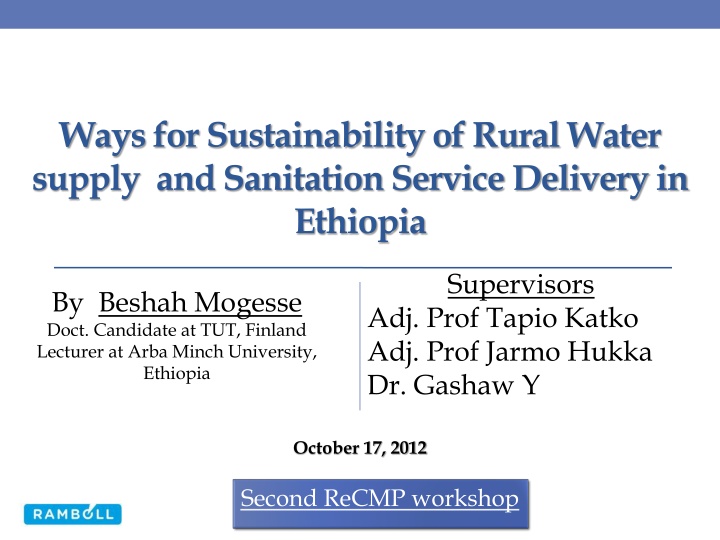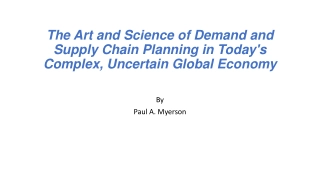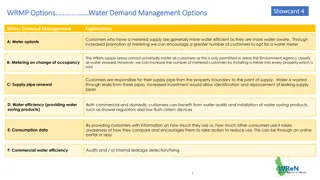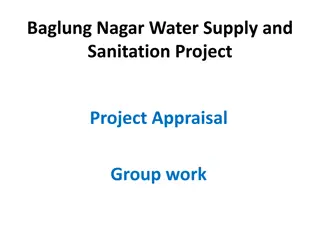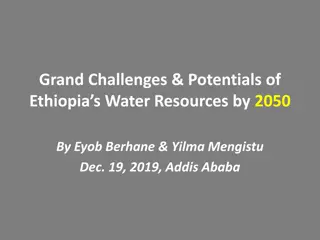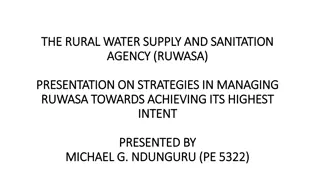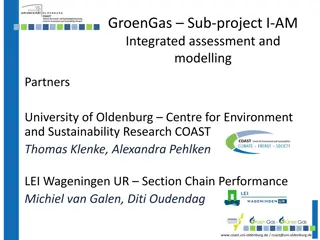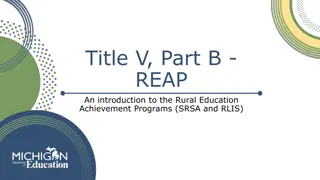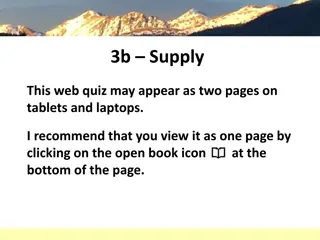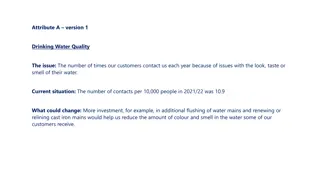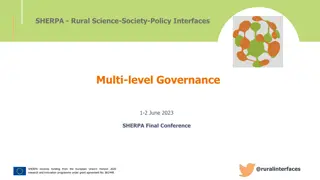Sustainable Rural Water Supply in Ethiopia
This research focuses on the sustainability of rural water supply and sanitation service delivery in Ethiopia, addressing the challenges, impacts on health and education, and the importance of functional water systems for community development. Efforts towards achieving MDGs, functionality issues, and the need for sustainable delivery are discussed.
Uploaded on Mar 06, 2025 | 3 Views
Download Presentation

Please find below an Image/Link to download the presentation.
The content on the website is provided AS IS for your information and personal use only. It may not be sold, licensed, or shared on other websites without obtaining consent from the author.If you encounter any issues during the download, it is possible that the publisher has removed the file from their server.
You are allowed to download the files provided on this website for personal or commercial use, subject to the condition that they are used lawfully. All files are the property of their respective owners.
The content on the website is provided AS IS for your information and personal use only. It may not be sold, licensed, or shared on other websites without obtaining consent from the author.
E N D
Presentation Transcript
Ways for Sustainability of Rural Water supply and Sanitation Service Delivery in Ethiopia Supervisors By Beshah Mogesse Doct. Candidate at TUT, Finland Lecturer at Arba Minch University, Ethiopia Adj. Prof Tapio Katko Adj. Prof Jarmo Hukka Dr. Gashaw Y October 17, 2012 Second ReCMP workshop
Outline Background Research questions Research objectives Methodology Selected kebeles from different woreda Few field observation
Background 2.5 billion People of the developing countries lack improved sanitation facility where as over 780 million are without safe drinking water (Unicef, 2012) The problem is multidimensional it related with health, education, socio-economy and privacy (dignity) Waterborne diseases caused due to lack of adequate sanitation result in health problem rural community spent significant amount of money for medication from their little annual income and to make the matter worse the working force deprived from the developmental activity.
Contd Children spent their time in fetching water and they stay away from their school thus the futurity of the children and the need of education remain unattainable Where there is no sanitation facilities women and girls suffer more due to privacy and losing dignity. When we think about Sustainable development, the primary thing to be addressed should be the provision of water supply and sanitation for all. And it have to be sustainable delivery.
Contd For the same reason, efforts have been made towards water supply and sanitation coverage in developing countries following the MDGs. The campaign is massive and involves several donors and actors, who are investing huge money and human resources. Thus, we need to give equivalent attention to functionality as currently we do for the coverage of water and sanitation facilities.
Contd Because, water points that estimated to be 25% of the implemented in any year found to be non-functioning in two years of their inauguration and 33-50% of the overall water supply systems become none functioning before their expected service life (Dandida, 2007) (WaterAid, 2011) and (Taylor, 2009).
Background What is CMP and how it emerge? Community Development Fund (CDF) model in Ethiopia is introduced in 2002 to Ahmara Region by the support of the Government of Finland (Harold lockwood, 2011, p 128). It was developed under the Finish-supported Rural Water Supply and Environmental Programme (RWSEP). Having had started in Amhara in 1994 now it is running in benishangul Gumuze (Chaka et al., 2011) CDF an implementation approach strengthening ownership feeling over services, and improve transparency in the use of fund and quality of system (Harold lockwood, 2011, p 104) which focuses on
Why CDF come to exist? Efficient utilization of the Partners resources: Enabling an environment for optimizing woredas capacity Establishing a genuine role of the communities for sustaining the benefits of investments Building up the private sector s role in construction, maintenance and spare part supply Creation of decentralized, material, goods and services supply chain, including spare parts supply (Closure of RWSEP, 2011)
Introduction Since August 2011 CDF is incorporated into the National WASH Implementation Framework. The principles and basic procedures of the CDF approach are built into the WaSH program as part of the Community Managed Project (CMP) funding mechanism (WIF, 2011). Community Managed Projects (CMP) and nationwide scaling-up started 2011 to 2014.
Statement of the Problems Water supply coverage of the country, especially the rural is so small; Constructed water points not sustainable; The scientific implication of CMP is not studied so far and Appropriate approach of implementation is vital in attaining MDGs
Research questions Is CMP approach the best of other managed projects ? Is there significant impact over the past projects executed by the Finnish-Government approach when compared with none CDF and CMP? under CDF and CMP Can indigenous knowledge of water system management contribute for sustainability of water and sanitation facilities? What experience be obtained from WMP and NGOMP, and how we can incorporate them in CMP to come up with sustainable water and sanitation delivery?
Objectives To investigate sustainability of Rural water supply systems and evaluate advantages and disadvantage of CMP comparing with other approaches. Specific objectives To identify principal factor(s) of none functionality of water systems in Ethiopia To learn the relationship between principal factors and approaches, and the significance of their interface on sustainability. Investigating good experience of indigenous knowledge of water supply sources management. Come up with a new approach integrating the advantage of approaches under consideration. Scalability of CMP to medium and large scale schemes ??? the scientific reaction of CMP on
Methodology Methods to be used in this research are ideal, cross- sectional survey and case study. Base line study Water and Sanitation project Cross-sectional Subsequent study with (after) improvement Survey without improvement Control Area/Village Cross-sectional study: in selected Woredas of Amhara and Benishangul Gumuze regions
Contd Case study Base line study Subsequent study with (after) improvement Water and Sanitation project Control Area/Village Case study: will be done in Konso and Borena where there are good indigenous water management system.
Contd The surveys expected to collect both qualitative and qualitative data, with the help of group discussion, questionnaire and observation. information sources of the study : WASHCO, elders and local leaders, woreda implementing agencies and user communities. water officers/technicians,
Site selection and criterion The Finn-WASH project has five intervention Woredas Of which Dibate, Pawi and Mandura were considered due to Having multi approach projects Accessibility and availability of medium and large scale schemes by CDF Google Earth Google Earth
Site selected Mandura Woreda Sr. No Organizatio n UNicef PA Selected PAs 1 Ejenta, Tumadalush, Dunzababuna, Du a gubash, Du a maksegnt, Tuni, Gilgel Beles, jigda silase, Adida #2, Photo majare and Genet mariam adida #2 photo majare, Du a gubash Dunzababuna, Du a gubash, Du a meksegnt, Jigda silase, Adida #2, photo majare and Genet mariam 9 shallow wells ------ 6 will be considered in the research stratified Random sampling 40 hand dug wells ---- 16 will be considered in the research by stratified random sampling The rehabilitation of the Ali Spring will also include as how to upscale CDF/CMP approach 1. Dunzababuna, 2. Du a gubash 3. Adida #2 4. photo majare 5. Genet mariam FinnWASH 2 3 4 5 EBM CRS Chisp Pawi Woreda
Dibate Parzayit, Simanda and Kido PAs are selected as research focus Due to serious breakdown and community ownership conflict
Whom I met and their comment COWASH staff== Amhara Region Abreham Kebede (Technical Advisor) The region is where the Finland-Ethiopia bilateral project running for two decades The intervention is large, inters of: Many administration units 271/470 coverage Different aged water schemes (Since 1994). Different climate Approaches (RWSEP CDF CMP) and Availability of sister organization for comparison
Site selection criterion The criterion for selection of woredas in Amhara Region are Worwdas which involve CDF/CMP before 2 years Woredas where there is water schemes that constructed by other approaches Climate regions (woredas of Humid, semi-arid and arid) and Accessibility
Selected Sr No Woreda 1 Farta Kebele (PA) Arga Zuria Awzet Ayiban ibi Kolay Kanato Ata Saharna Shina Wagatera Wereta Zuria Kuhar Mikael 12 13 14 15 16 17 18 East Estie Mikri Hana East Estie Mikri Kuskuam East Estie Gena Memcha East Estie Licha East Estie Disekuam East Estie Alemaya East Estie Gindatiba (kimir Dingia 2 3 4 5 6 7 8 9 10 11 Farta Farta Farta Farta Farta Farta Fogera Fogera Fogera Fogera 19 20 21 22 23 24 Guangua Guangua Guangua Guangua Guangua Guangua Bizrakani Tiru Birhan Dega Abo Tirgi Dangula Addis Alem 25 26 Dega Damot Dega Damot Zikual Wegem Fenkatit Gindwiha Shangi Dereke Feresbet Michael 27 28 Dega Damot Dega Damot
Field observation It is difficult to get the right responsible and knowledgeable person at woreda level due to meeting, and other duties. All woreds of the Metekel Zone entirely relay on the zone s technical staff. Sanitation issue under each woreda considered as secondary element according to the preliminary discussion we had with woreda s water offices. Off course village(s) which claim fund for water development imposed to have toilet for each members to get an approval. In my view they are rarely assisted technically and trained for behavior change. Thus, I have doubt whether such toilets are in use or not. Staff turnover is obstacle to the progress of projects and created technical gap
Publications Plan To show how the approach is developed, achievements and pros and cons and its progress when compared with non-CMP approach schemes done by Finland-Ethiopia cooperation since 1994 There are several factors which affect the sustainability of water systems like, Technical, social, economical and environmental. Thus , a through investigation will be done on before going to evaluate approaches Here different implementation approaches evaluated with respect to the principal factor(s). Moreover, functionality rate, implementation rate, and acceptability will be investigated and ranked based of their significance to sustainability Historical development of CMP Investigation of principal factor that favor none functionality in rural water supply Is principal factor(s) dependent of approaches? Countries like Ethiopia, which have divers culture and living norm, is difficult to implement same approach for all. Traditionally some communities are endowed good management practice of their water sources. Thus, it is very important to learn why such systems are more sustainable than modern schemes. The result surly point out what to do in our new approach. How indigenous knowledge contribute for the sustainability of water points Developing New or improving approach from experience of all approaches and the indigenous knowledge Bringing advantages of different approaches together, by avoiding their short coming for sustainable development of rural water supply and further suiting for other developmental activities .
1. Community Managed Project in implementing rural water supply in Amhara region of Ethiopia - Nabin Sharma, TUT 2. Sustainability of Water Services Implemented Using CMP Approach - Ahmed Muhumed, HAMK 3. Assessment on CMP Approach in Water Supply and Sanitation Schemes: A Case of Benishangul-Gumuz Regional State - Meron Mebratu, AAU 4. A Comparative Study on Woreda Community Managed Rural Water Supply Projects Yewondwossen Tesfaye, Developing Rural Managed and
Community Managed Project in implementing rural water supply in Amhara region of Ethiopia Nabin Assessment on CMP Approach in Developing Rural Water Supply and Sanitation Schemes: A Case of Benishangul-Gumuz Regional State Meron z A Comparative Study on Woreda Managed and Community Managed Rural Water Supply Projects Ways for sustainability of RWSS YW T Sustainability of Water Services Implemented Using CMP Approach Ahmed x
